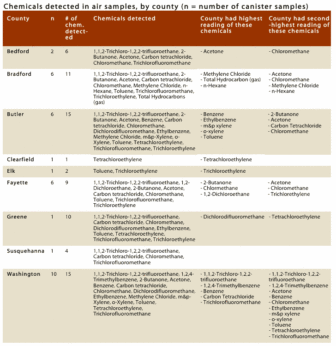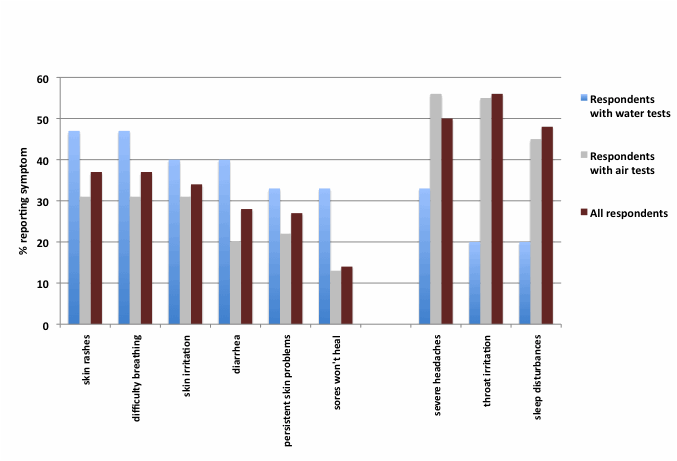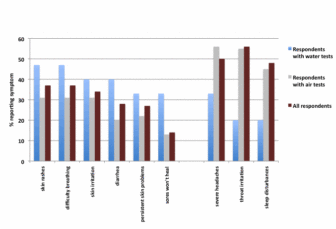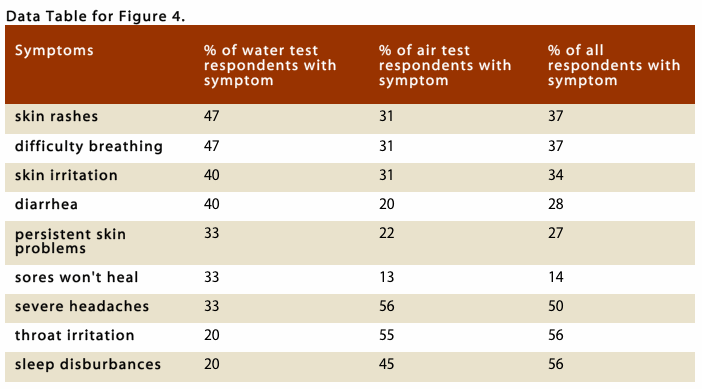How Shale Gas Development Risks Public Health in Pennsylvania
Where oil and gas development goes, health problems often follow.
For many people across the United States, this statement has rung painfully true for a long time. As the drilling boom picks up speed and reaches more places, it is now resonating in new communities.From a growing number of stories told by individuals nationwide to conferences held by academics and public agencies, the “dots” between health symptoms and gas facilities are very slowly but surely being connected.
The health survey and environmental testing project described in the following pages is part of this critical process. Between August 2011 and July 2012, Earthworks’ Oil & Gas Accountability Project (OGAP) investigated the extent, types, and possible causes of health symptoms experienced by people living in the gas patches of Pennsylvania.
The findings of this study stand in strong contrast to statements—often made by industry representatives and policymakers seeking to expand drilling—dismissing claims of health impacts as “personal anecdotes” and isolated incidents. Directly impacted people are frequently told that what they experience is a random occurrence and that some other source—traffic, lifestyle choices, family disease history, household products—is to blame.
We know that the gas and oil industry uses toxic substances that harm human health. For example, of about 300 compounds identified as being used in hydraulic fracturing to extract gas, 65 are listed as hazardous by the federal government. In turn, this creates a real potential for negative health effects in any area where gas development occurs. While general scientific links regarding the effects of such exposure have been established, research on the direct relationship between health problems and gas and oil activities has been limited and inconsistent.
Even as knowledge of impacts evolves slowly, gas and oil extraction and production continue to accelerate rapidly—allowing industry to put still-emerging technologies to use without first establishing their safety. State regulations remain too lax and outdated to prevent the impacts of modern-day energy development, and regulatory agencies are often unable to conduct the oversight and enforcement needed to protect air and water quality and, in turn, health and communities. Magnifying the consequences of this situation are special exemptions in provisions of the nation’s bedrock environmental laws, which allow the industry to stifle key information and pursue risky practices.
The overall result is that the burden of proof remains heaviest for impacted individuals and communities themselves. Companies can continue to avoid responsibility and downplay health- related concerns. Decisionmakers can continue to sidestep the need to recognize the damage and hold companies accountable.
Yet the realities, including those described in this report, can be documented—and when they are, they can no longer be denied. When many people in many places where gas development is occurring have similar health complaints, something is clearly wrong. Earthworks believes that when health problems occur, action to solve and prevent them must follow.
Symptoms associated with chemicals detected in air tests
The air tests conducted for this project detected a total of 19 chemicals that may cause sinus, skin, ear/nose/mouth, and neurological symptoms, 17 chemicals that may affect vision/eyes, 16 that may induce behavioral effects, 11 that have been associated with liver damage, 9 with kidney damage, and 8 associated with digestive/stomach problems. In addition, the brain and nervous system may be affected by 5 chemicals that were detected, the cardiological system by 5, muscles by 2, and blood cells by 2. The chemicals and their potential health effects (by symptom category) are shown in the table below. Information on potential health effects related to chemicals comes from: Agency for Toxic Substances and Disease Registry (ATSDR) “Toxicological Profiles” (accessed July 30, 2012); and New Jersey Department of Health “Right to Know Hazardous Substance Fact Sheets” (accessed July 30, 2012).
Association of symptoms and distance from facilities
When the most prevalent symptoms reported by survey participants were broken out by age and distance from facility, some differences were notable. In most age groups, symptoms are more prevalent in those living closer to facilities than those living further away.
As seen in Figure 1 in the report (and the table below), for most symptoms and in most age groups a higher percentage of the subset living within 1500 feet of an oil and gas facility had symptoms than did the entire age group. For example, 69 % of survey respondents between the ages of 1.5 and 16 who lived within 1500 feet of a gas facility reported throat irritation. Only 57 % of all 1.5-to-16-year-olds reported throat irritation. In sum, while this data analysis does not definitively prove that living closer to an oil and gas facility causes health problems, the data suggest a relationship between distance from facility and occurrence of symptoms.
Data on air results by county
When the data from air canister samples were broken out by county, we found the highest number of VOCs detected in samples from Washington County (15), Butler County (15), Bradford County (11), and Fayette County (9). Washington County also had the highest measured concentration of five, and the second highest concentration of 11 VOCs.
Samples from Butler and Bradford counties had the highest concentrations of five and three VOCs, respectively.
Five chemicals were detected in all nine of the samples from Washington County and in the six samples from Butler County: 1,1,2-Trichloro-1,2,2-trifluoroethane, Carbon tetrachloride, Chloromethane, Toluene and Trichlorofluoromethane.
Our results show more VOCs and higher concentrations of the chemicals in Washington County than other counties. This does not necessarily mean that Washington County has worse air quality than other counties in this study. More research would be needed to confirm that, especially given that more samples were taken in Washington than in other counties in our study, thus increasing the chances for detection of VOCs. In addition, the canister samples reflect air quality at one point in time. It is possible that in some places we did not sample when facilities were emitting high concentrations of chemicals, or perhaps the wind was blowing contaminants away from the canisters.
Differences in symptoms based on respondents with air and water tests
Exposures to chemicals and pollutants related to oil and gas development may come from multiple sources (e.g., contamination of water sources from leaking waste impoundment pits and tanks or spills of chemicals or wastewater; air emissions from pits, tanks, compressors, wellheads and other oil and gas infrastructure, spills of chemicals or wastes, etc.).
Many survey respondents indicated that they had concerns about contamination of their drinking water and/or exposure to air emissions from nearby gas development. (Note: The survey did not specifically ask about water concerns, but some survey respondents offered that information. Additionally, some respondents conveyed that information to Earthworks through interviews or initial discussion related to the survey.)
Figure 4.
Symptoms from respondents with water & air tests
Click chart thumbnail for larger view
Earthworks conducted water and air tests at some of the homes of survey respondents. There were 15 survey respondents who had water tested at their homes, and there were 55 respondents who had air tests conducted at their homes.
It is interesting to note, as seen in the chart, that a higher percentage of those who perceived that they had problems with water reported symptoms such as diarrhea and skin issues – symptoms that may be associated to ingesting or bathing in water that contains contaminants. Those who perceived that air exposure to gas-related contaminants was a primary concern more often reported severe headaches and throat irritation, which may be associated with breathing in air contaminants.
The results were complicated by the fact that some of the people receiving water tests also expressed concerns about air exposures (46% reported smelling odors that they associated with gas development), and 43% of those receiving air tests also had water concerns. Therefore, the following analysis does not prove that those receiving water tests had symptoms caused by contaminated water, or that they did not have symptoms related to air exposures. Nor does it prove that those receiving air tests had symptoms solely related to air exposures.
The results, however, do suggest that this is an area that bears further scrutiny and research.
For More Information
- Press release
- Gas Patch Roulette: Summary Report
- Full report, high res
- All available information associated with the report, including support documentation not in the full report.





